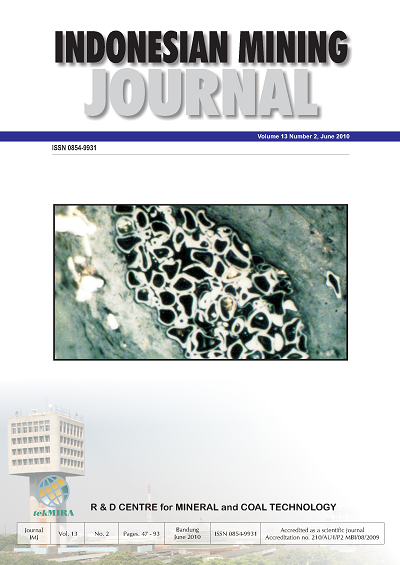TRENDS IN SUPPLY / DEMAND FOR INDONESIAN COAL PERIOD 2005 - 2025
DOI:
https://doi.org/10.30556/imj.Vol13.No2.2010.528Keywords:
Production, consumption, export, projection, mining ageAbstract
In 2008, Indonesia mineable coal reserve was recorded around 7.12 billion tons. During that year, around
231.18 million tons were exploited. Of such a figure, 69.44 million tons went to domestic market and the rest belonged to export. Yet, in 2025 the need of coal for local consumption may reach 192.33 million tons that include 99.86 million tons for steam power plant, 30.58 million tons for cement industries, and 17.59 million tons for textile industries. Pulp and other industries may consume 2.92 million tons and 41.39 million tons respectively. It is assumed that in 2025, Indonesian coal export will increase to 260.92 million tons
Coal export is assumed to increase figuring Coal Mining Agreement as the biggest exporter (94.03%). The rest goes to Mine authority (3.55%) and State-owned Enterprises (2.43%). However, the possibility of unre- corded coal utilization for ether domestic use and export reaches 51.66 million tons. As a result, it is presumed that Indonesian coal production in 2025 is around 504.92 million tons. The production rate during 2010-2025 is 4.9% per annum. According to the above condition, the mineable coal reserve of 7.12 million tons will probably be finished for about 18 years. In addition, the coal-steamed power that operates until now has an age of 26 years. If the reserve is not well-managed, it will immediately be finished in the shorter time. That is why, it needs an anticipative step of a policy concept that can maintain a sustainability of the domestic coal stock by implementing a limited export.
References
Directorate Program Supervision of Mineral, Coal and Geothermal, 2003. Indonesia Mineral, Coal, Geothermal and Groundwater 2008. Directorate General of Mineral, Coal and Geothermal, Min- istry of Energy and Mineral Resources, Jakarta, 2003.
Directorate Program Supervision of Mineral, Coal and Geothermal, 2004. Indonesia Mineral, Coal, Geothermal and Groundwater 2008. Directorate General of Mineral, Coal and Geothermal, Min- istry of Energy and Mineral Resources, Jakarta, 2004.
Directorate Program Supervision of Mineral, Coal and Geothermal, 2008. Indonesia Mineral, Coal, Geothermal and Groundwater 2008. Directorate General of Mineral, Coal and Geothermal, Min- istry of Energy and Mineral Resources, Jakarta, 2008.
Directorate Program Supervision of Mineral, Coal and Geothermal, 2009. Indonesia Mineral, Coal, Geothermal and Groundwater 2008. Directorate General of Mineral, Coal and Geothermal, Min- istry of Energy and Mineral Resources, Jakarta, 2009.
Gujarati, D., 1978. Econometrics. Bernard Baruch College City University of New York,Basic, McGraw-Hill Kogakusha, LTD, Tokyo. p. 11 – 25.
Kuncoro, M., 2004. Metode Kuantitatif : Teori dan Aplikasi Untuk Bisnis dan Ekonomi. Penerbit dan Pencetak AMP YKPN, Yogyakarta. p. 75 – 128.
Miranti, E., 2008. Prospek Industri Batubara di Indo- nesia, Economic Review, Analisis Riset Bisnis dan Ekonomi pada Bank BUMN.
Mujib, Suseno, T., dan Saleh R., 1998. Pengkajian Keterkaitan Sektor Pertambangan Batubara Terhadap Struktur Perekonomian Indonesia, Puslitbang Teknologi Mineral, Bandung.
PLN, 2009. Kebutuhan Pasokan Batubara Untuk Pembangkit PT. PLN (Persero) dan IPP Tahun 2009-2015, Jakarta.
Suherman, I., Suseno, T., Jafril, Sujarwo dan Sabur, U., 2006. Kajian Batubara Nasional. Puslitbang Tekmira, ESDM, Bandung.
Sukhyar, R., 2009. Sumberdaya dan Cadangan Batubara Indonesia, Seminar dan Workshop “In- donesian Coal Conference”. Gran Melia, Jakarta, 18 Maret 2009.
Suseno, T., Suherman, I., Jafril, Sujarwo dan Sabur, U., 2004. Pola Distribusi Batubara untuk Boiler Industri Tekstil di Provinsi Jawa Barat. Puslitbang Tekmira, Bandung.
www.dbm.djmbp.esdm.go.id, 2009. Laporan Tahunan Perusahaan Batubara : Produksi, Rabu, 25 Maret 2009 10:46:46 AM.
www.esdm.go.id, 2009. ESDM - Mulai Tahun 2010 Ekspor Batubara Dibatasi, 27 Sep 2007.
Downloads
Issue
Section
License
Indonesian Mining Journal provides immediate open access to its content on the principle that making research freely available to the public to supports a greater global exchange of knowledge.

This work is licensed under a Creative Commons Attribution-NonCommercial 4.0 International License.













